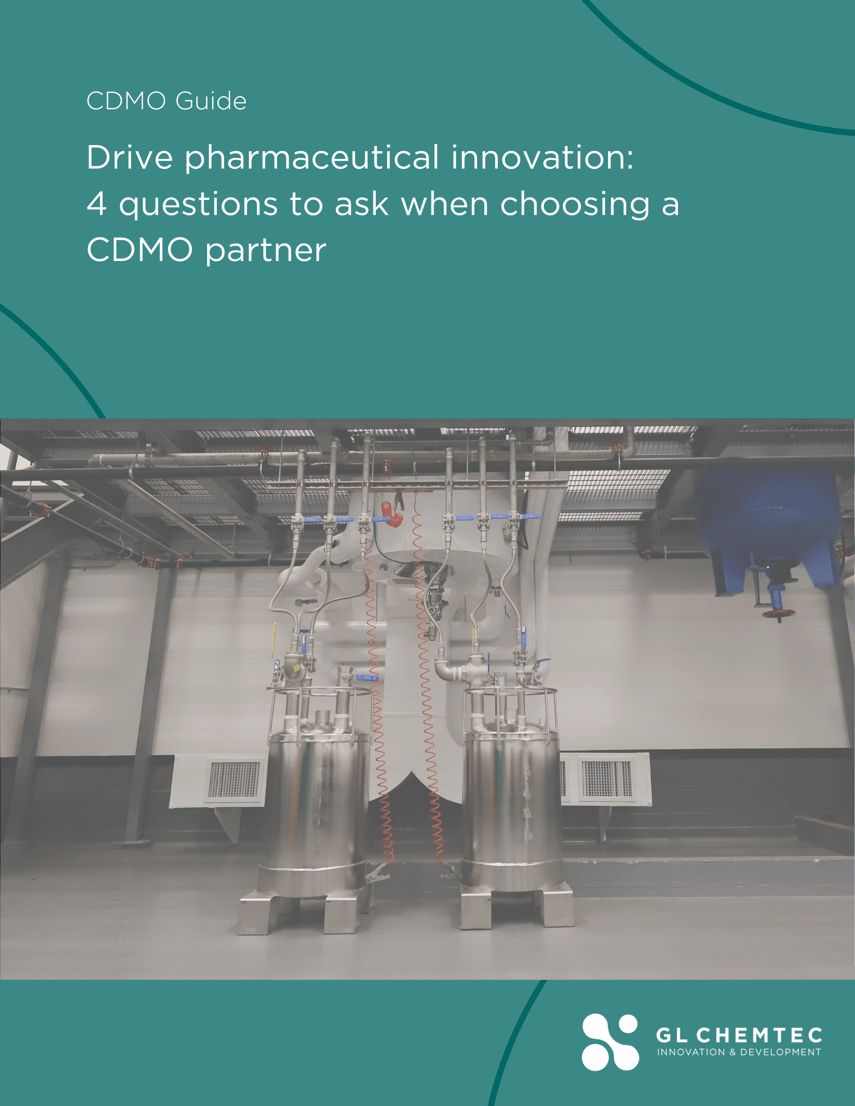Download the latest GL CHEMTEC guide to learn more about how to choose the right CDMO partner.
Revolutionizing Drug Development: CDMO Trends Defining 2025 and Beyond

The Contract Development and Manufacturing Organization (CDMO) market is expected to grow to $309.5 billion (USD) by 2028, at a projected CAGR of 6.74%. This growth is being driven by surging global demand for outsourced services in the pharmaceutical sector, including drug development, manufacturing, and analytical testing.
Let’s take a closer look at the trends behind this significant market growth, and some of the key considerations you should keep in mind when searching for a strategic partner.
Pharmaceutical and Biotech Trends
Manufacturing Expertise as a Market Differentiator
The pharmaceutical and biotech sectors have experienced significant growth over the last five years, with the latter growing from $266 billion in revenues in 2019 to a projected $505 billion by 2026.
Many of these new firms, however, have struggled to bring their discoveries to market, often because they lack the necessary infrastructure, equipment, and expertise across the production journey.
As a result, more and more companies are seeking out strategic partners, with versatile CDMOs often best positioned to help bring products to market. According to an analysis by EY Parthenon, the customer base for CDMOs has shifted from primarily big pharmaceutical companies to these smaller biotech firms, many of which are developing drug pipelines without manufacturing experience.
To meet this demand, forward-thinking CDMOs have evolved into comprehensive, end-to-end service providers that can quickly expand capacities and capabilities. This trend is reshaping the pharmaceutical and biotech sectors, with CDMOs increasingly leading innovation and playing a central role in the development of modern medicines.
The Emergence of Increasingly Complex Drugs
The pharmaceutical industry is also witnessing a shift toward the development of increasingly complex drugs, particularly small-molecule drugs for rare diseases, encompassing injectables, ophthalmic drugs, and otic dosage forms. Overall, the trend is being driven by the prevalence of insoluble APIs, the aforementioned biologics, and 505(b)2 applications, which can pose many challenges in scale-up, regulatory pathways, formulation, excipients, and characterizations.
As a result, more and more pharmaceutical companies are turning to CDMOs to provide specialized expertise and equipment to meet deadlines, stay on budget, and ensure quality and safety while manufacturing these products. This has proven increasingly successful. According to McKinsey, more than 70% of new molecular entity (NME) revenues have come from externally sourced products since 2018, with approximately 45% of these products sourced before launch. They also found that companies that effectively leverage external innovation demonstrate significantly higher productivity, outperforming their peers by three to eight times.
Unsurprisingly, the reliance on external sourcing continues to grow, with the contract manufacturing market projected to grow from $176 billion in 2023 to $258 billion by 2028.
It’s also worth pointing out that in the last 10 years, the number of molecules in R&D pipelines has more than doubled, with growth rates for small and large molecules hovering around 5% and 12% CAGR. The molecules in these development pipelines represent a key driver for the CDMO industry for the future, as the average drug can take over 10 years to go from discovery to commercialization.
The Continued Adoption of Advanced Technology
According to a 2023 survey by GlobalData, 39% of healthcare industry professionals believed that AI would be the emerging technology with the biggest impact on the pharmaceutical industry, followed by Big Data with 27%. As we explored in our blog post on AI’s role in drug discovery, these technologies are already transforming small molecule API development. AI-driven molecular modeling, computational chemistry, and predictive analytics are optimizing processes and accelerating innovation.
Seeing the potential (and not wanting to be left behind), many pharmaceutical companies are now seeking out CDMOs who are committed to investing in advanced technology and state-of-the-art facilities. Working with forward-thinking CDMOs enables these companies to gain ongoing access to cutting-edge, specialized expertise and resources, ultimately boosting productivity, efficiency, and quality assurance.
Big Pharma’s Transition Period
The pharmaceutical industry continues to navigate a period of significant transformation, driven by rising operational costs, heightened government scrutiny of mergers and acquisitions (M&A), and an unpredictable macroeconomic climate. While layoffs peaked in 2023, the industry has since focused on optimizing operations and reallocating resources to adapt to the evolving landscape.
The Inflation Reduction Act (IRA) remains a critical factor shaping the industry’s trajectory. The legislation mandated that the U.S. government negotiate prices for top-spending Medicare drugs, setting prices between 25% and 60% of list prices. Small molecules are eligible for price negotiations 9 years after approval, while biologics face negotiations 13 years post-approval.
Meanwhile, escalating trade tensions and newly imposed tariffs on key raw materials and pharmaceutical ingredients have further complicated supply chains, increasing costs for manufacturers. As a result, companies are reevaluating sourcing strategies and supply chain resilience, with some shifting toward domestic or nearshore suppliers to mitigate risks.
With these challenges, the industry is expected to increase outsourced services and M&A activities, reallocating funds that were previously directed to the emerging pharma sector and further driving CDMO industry growth.
OnShoring to Secure Supply Chains and Enhance Scalability
Like other industries, the pharmaceutical industry has understood the vulnerabilities associated with overseas suppliers over the last few years. This has led to a growing trend known as “onshoring,” which involves the relocation, either entirely or partially, of manufacturing and production processes to domestic facilities and partners.
Companies are now increasingly focused on fortifying their supply chains against system shocks and trade uncertainties, particularly when it comes to small molecule APIs and customized polymers. This has propelled a growing demand for reliable partnerships with local, or regional, CDMOs, which enables a more secure supply chain, and a much more collaborative approach. This last point is especially important, as a truly collaborative partnership allows your CDMO to better meet tight timelines, adapt to evolving project needs, and scale quickly by anticipating and preparing for your milestones.
Key Considerations for Finding a CDMO Partner
With these trends in mind, there are a few key questions you should consider when searching for a CDMO partner:
- Where are they located?
North American CDMOs provide several advantages, including security of supply, easier communication and site visits, enhanced IP protection and regulatory compliance, and a lack of language or cultural barriers, among other benefits. - Do they provide comprehensive support?
The very best CDMOs combine diversified expertise and specializations, an ability to scale, and a focus on problem-solving to provide comprehensive support through multiple stages of the drug development process. - Do they have advanced technology and facilities?
Top-tier CDMOs are consistently investing in advanced technology and state-of-the-art facilities, including: cutting-edge R&D labs, fully-equipped kilo labs and scale-up suites, pilot plants for seamless scaling, class 6 cleanrooms, GMP cleanrooms, and more. - Can they help you accelerate timelines and scalability?
To ensure a successful long-term partnership, your CDMO must function as an extension of your in-house team, and to do this, they need to have a flexible, collaborative approach to meet tight timelines and adapt to shifting project needs.
Four key considerations for choosing the ideal CDMO partner

.png?width=800&height=241&name=GLChemtecLogo%20(NEW).png)
.png?width=1000&height=301&name=GLChemtecLogo%20(NEW).png)